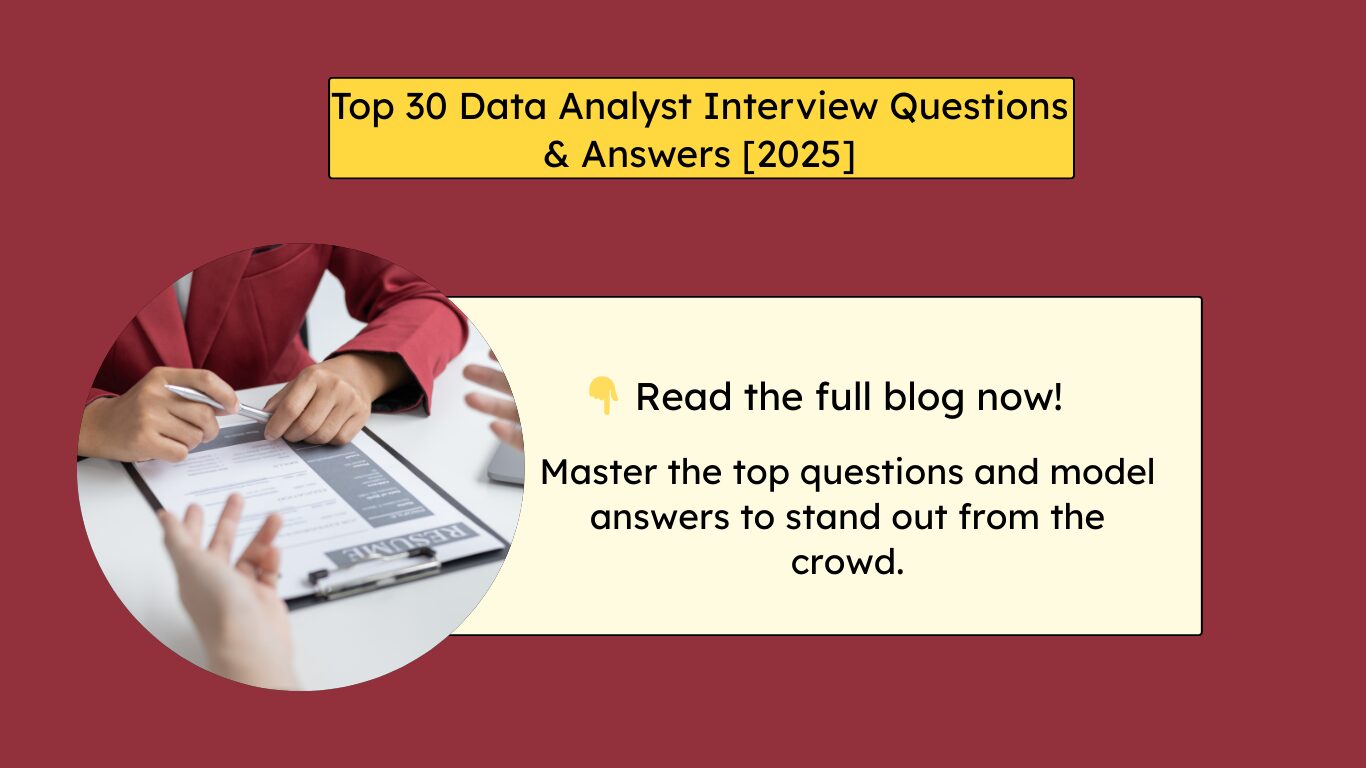Are you preparing for a career in data analysis? As a fresher, it can feel overwhelming to face your first interview. Most recruiters focus on data analyst interview questions for freshers that test your knowledge of SQL, Excel, statistics, and problem-solving. This blog covers the most common and important questions along with sample answers to help you succeed.

Interview Questions for Freshers
1. What is data analysis, and why is it important?
Data analysis is the process of collecting, cleaning, and examining data to find useful insights. Think of it as being a “detective of numbers.” For example, if an e-commerce company notices a sudden drop in sales, a data analyst investigates customer behavior, marketing campaigns, and website performance to discover the reason.
Why it’s important:
- Helps businesses make informed decisions
- Identifies patterns and trends
- Reduces risks by predicting problems in advance
2. Describe the main responsibilities of a data analyst.
As a fresher, you might not handle advanced projects, but you’ll still be expected to support the team with core tasks. A Data Analyst typically:
- Collects data from multiple sources (databases, Excel sheets, APIs)
- Cleans and prepares the data for accuracy
- Analyzes trends using SQL, Excel, or Python
- Creates reports & dashboards with tools like Tableau or Power BI
- Presents insights in simple words so managers can act quickly
3. What skills should freshers focus on to become a Data Analyst?
Freshers should build strong skills in SQL, Excel, statistics, and visualization tools like Tableau or Power BI. For example, knowing how to use pivot tables in Excel can help you summarize thousands of rows of sales data into an easy-to-read report.
4. What is the difference between data and information?
Data is raw and unprocessed—for example, a list of 500 sales transactions. Information is when that data is processed into meaningful insights, such as “Product A sold 40% more than Product B in July.” Employers want to see if you understand this fundamental distinction.
5. Explain structured vs unstructured data.
Structured Data: Organized in rows and columns, easy to analyze using SQL or Excel. Example: a customer database with names, ages, and addresses.
Unstructured Data: No fixed format, harder to process. Example: customer reviews, emails, or social media posts. A good analyst should be familiar with both.
6. What is data cleaning, and why is it important?
Data cleaning is correcting or removing inaccurate, duplicate, or incomplete data. Without this step, analysis may lead to wrong conclusions. For example, if customer ages are missing in half the dataset, your age-based sales analysis may be misleading.
7. How do you handle missing values in a dataset?
There are several methods:
- Remove rows or columns with missing data (if minimal).
- Replace with mean or median for numerical values.
- Replace with the most common category for categorical values. For instance, if you’re analyzing student marks and some scores are missing, filling them with the class average ensures balance.
Excel Interview Questions for Data Analyst
Excel remains one of the most important tools for data analysts, even in the era of advanced tools like Python, R, and Tableau. Recruiters often check whether candidates—especially freshers—can use Excel to handle, analyze, and visualize data effectively. Here are the most frequently asked Excel Interview Questions for Data Analyst roles, with simple answers to help you prepare.
Top Excel Interview Questions for Data Analyst
1. What are the key uses of Excel for a Data Analyst?
Excel is used for data cleaning, data analysis, reporting, visualization, and creating dashboards. It’s ideal for handling small to medium datasets.
2. What are Pivot Tables, and why are they important?
Pivot tables allow you to summarize large datasets quickly. For example, you can group sales data by region and product to see performance trends instantly.
3. What is the difference between VLOOKUP and HLOOKUP?
VLOOKUP: Searches for a value vertically in a column.
HLOOKUP: Searches for a value horizontally in a row. Example: Use VLOOKUP to find an employee’s department based on their ID.
4. Explain INDEX and MATCH functions.
INDEX: Provides a cell’s value at a given row and column.
MATCH: Finds the position of a value within a row/column. Combined, they’re more flexible than VLOOKUP.
5. What are conditional formatting rules in Excel?
Conditional formatting highlights cells based on criteria. Example: Highlighting all sales above ₹50,000 in green and below ₹10,000 in red.
6. What is the difference between absolute, relative, and mixed cell references?
- Relative ($A1): Changes when copied.
- Absolute ($A$1): Fixed reference, doesn’t change when copied.
- Mixed (A$1 or $A1): Partially fixed.
7. What is the difference between COUNT, COUNTA, COUNTBLANK, and COUNTIF?
- COUNT: Counts numbers.
- COUNTA: Counts all non-empty cells.
- COUNTBLANK: Counts empty cells.
- COUNTIF: Counts cells that meet a condition.
SQL Interview Questions for Data Analyst
SQL (Structured Query Language) is the backbone of data analysis. Whether it’s retrieving customer data, analyzing sales trends, or joining datasets, SQL skills are a must-have for every data analyst. In interviews, recruiters test your ability to write queries, handle large datasets, and optimize performance.
Top SQL Interview Questions for Data Analyst
1. What is SQL, and why is it important for Data Analysts?
The SQL language can be used to communicate with relational databases. It allows analysts to query, insert, update, and delete data. For a data analyst, SQL is essential to extract insights directly from databases.
2. What are the different types of SQL commands?
DDL (Data Definition Language): CREATE, ALTER, DROP
DML (Data Manipulation Language): SELECT, INSERT, UPDATE, DELETE
DCL (Data Control Language): GRANT, REVOKE
TCL (Transaction Control Language): COMMIT, ROLLBACK
3. What are JOINS in SQL? Explain types with examples.
Joins combine rows from two or more tables:
INNER JOIN → Returns rows from both tables matching each other.
LEFT JOIN → Returns all rows from left table + matched rows from right.
RIGHT JOIN → Returns all rows from right table + matched from left.
FULL OUTER JOIN → Returns all rows when there’s a match in either table.
4. How do UNION and UNION ALL vary from one another?
UNION: Combines results from two queries and removes duplicates.
UNION ALL: Combines results but keeps duplicates.
5. Explain Primary Key and Foreign Key.
Primary Key: Uniquely identifies each row in a table.
Foreign Key: Links one table to another using a reference to the primary key.
6. Difference between DELETE, TRUNCATE, and DROP?
DELETE: Removes rows but keeps structure (can use WHERE).
TRUNCATE: Removes all rows, faster than DELETE.
DROP: Deletes the table completely.
7. What is Normalization in SQL?
Normalization organizes data into smaller related tables to reduce redundancy. Example: Separating customer details and order details into different tables.
Conclusion
Cracking a Data Analyst interview as a fresher requires strong basics in statistics, SQL, Excel, and problem-solving. By practicing these Data Analyst Interview Questions for Freshers, you’ll build the confidence to face interviews and demonstrate your ability to analyze and interpret data effectively. Remember, interviewers value clarity and logical thinking as much as technical knowledge—so always explain your answers with simple examples.




